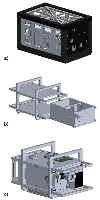Related Spacecraft
| Satellite | Status | Rocket | Launch | Orbit |
|---|---|---|---|---|
| OrCa2b (Orbital Calibration 2, OrCa2b, TDO-6?) | Operational? (No news found as of 2025-04-21) | Falcon 9, (Transporter-13) | 2025-03-15 | ? |
| OrCa2 (Orbital Calibration 2, TDO-5?) | not launched | Firefly Alpha, (Elytra), (ELaNa 42) | 2025-06-27 | not launched |
Last modified: 2025-04-21





